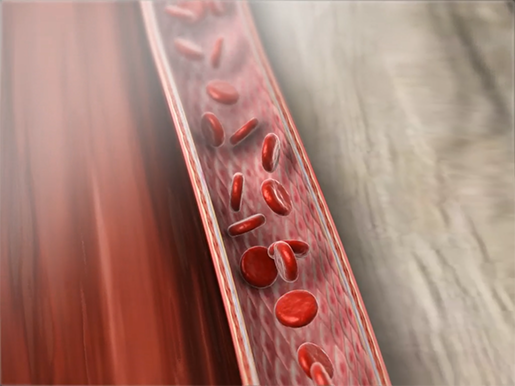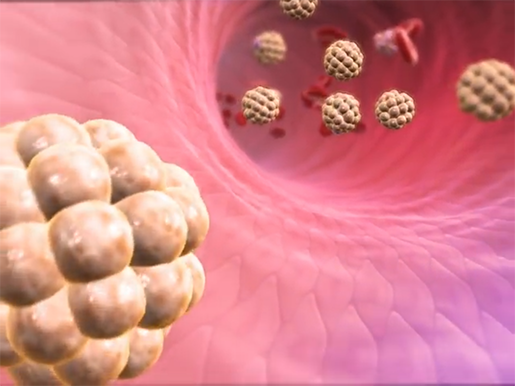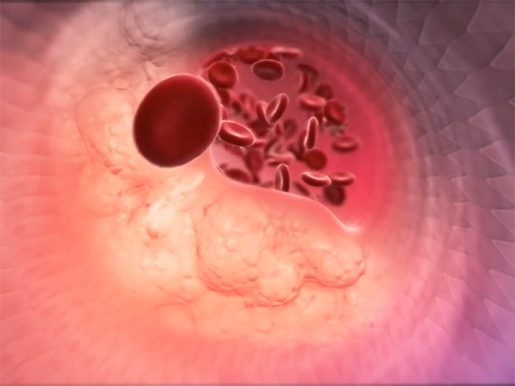Posted on 11/13/15 by Courtney Smith
As I get older, I try to be conscientious of what I eat, but the problem is that I'm always craving mac & cheese and there's nothing I can do about it. Resisting the urge to shove a block of sharp cheddar down my gullet with a macaroni chaser is, as they say in "Star Trek," futile. No matter how much I fight it, I eventually cave. My doctor isn't impressed. "Stop eating things so high in cholesterol," she pleads, and I nod seriously and say, "I hear what you're saying, but let's be realistic."
And so it goes.
More and more, we're warned about foods that are high in "bad" cholesterol and the dangers of having high cholesterol, but what does it all mean? Read on to find out!
Cholesterol is a waxy substance that helps maintain the structure of all of your cells and performs certain tasks, like producing hormones and vitamin D, as well as helping you to digest your food.
 Red blood cells flowing through an artery. Image captured from Physiology Animations.
Red blood cells flowing through an artery. Image captured from Physiology Animations.
On its own, cholesterol isn't inherently "bad." In fact, your body—particularly your liver—produces all the cholesterol it needs!
So, where does it all go wrong? Why do so many people have high cholesterol levels? Well, look no further than the foods you eat. Meat, butter, shellfish, cheese, and pastries all can be very high in cholesterol, which is a bummer because everyone knows that lobster mac & cheese is the best kind of mac & cheese on the planet. Obviously eating these things in moderation is fine, but too much of a good thing can be bad for you (except ice cream*).
Like a Hollywood classic for which I'll probably be sued for naming, "good," "bad," and "ugly" characteristics can be applied to cholesterol.
Two types of proteins carry cholesterol through your bloodstream: low-density lipoproteins and high-density lipoproteins, and too much of one or not enough of the other isn't a good thing. It's important to try and maintain a healthy balance between them.
 Cholesterol traveling through an artery. Image captured from Physiology Animations.
Cholesterol traveling through an artery. Image captured from Physiology Animations.
HDL cholesterol is the "good" cholesterol, as it carries cholesterol from other parts of your body back to the liver, which then removes the cholesterol from your body.
LDL cholesterol is "bad" because a high level of it can lead to a buildup of it in your arteries.
A buildup of LDL cholesterol is "ugly" because it can lead to a bunch of issues. Actually, why don't we talk about those right now?
Ah, coronary heart disease: the one threat that gets me on my feet and forces me to stay somewhat active. As we discussed previously, CHD is no joke.
What does heart disease have to do with cholesterol? A lot, actually. See, when there's a buildup of LDL in your artery walls, it narrows the amount of space through which blood travels. Add a buildup of other things, like calcium and fat, and you get plaque. When plaque accumulates in the arteries, it's known as atherosclerosis. When less blood flows, your organs don't get the amount of oxygen and nutrients they need. This can lead to stroke, heart attack, or even death.
 An artery narrowed by plaque buildup. Image captured from Physiology Animations.
An artery narrowed by plaque buildup. Image captured from Physiology Animations.
In CHD, the arterial walls of the heart become hard with plaque buildup and grow narrow, limiting oxygen to the heart. When there's a limited or lack of oxygen flow, tissues will die and heart attack can occur.
According to the Center for Disease Control, a whopping 73.5 million adults in the United States have a high LDL cholesterol level, which puts them at double the risk of heart disease than someone whose levels are normal. A high LDL cholesterol level usually doesn't come with symptoms, so many people have no idea if their blood cholesterol level is too high. Exercising, eating well, and not smoking will lower your risk of heart disease.
While it may be impossible for me to give up mac & cheese completely, I can certainly curb my intake. It won't be easy, but it's important. My very life may depend on it.
* I’ve been told that this is just wishful thinking on my part.
Be sure to subscribe to the Visible Body Blog for more anatomy awesomeness!
Are you a professor (or know someone who is)? We have awesome visuals and resources for your anatomy and physiology course! Learn more here.
- Anatomy and Physiology: Stroke Is No Joke: Always Act FAST
- Learn Muscle Anatomy: Of Dads and Rotator Cuff Injuries
- Anatomy and Physiology: 7 Facts about Cardiovascular Disease
Additional Sources:
1. CDC.gov
2. National Heart, Lung, and Blood Institute
3. Heart.org
When you select "Subscribe" you will start receiving our email newsletter. Use the links at the bottom of any email to manage the type of emails you receive or to unsubscribe. See our privacy policy for additional details.
©2026 Visible Body, a division of Cengage Learning